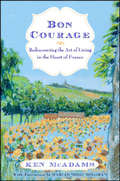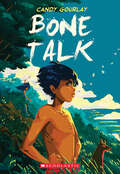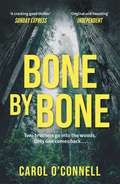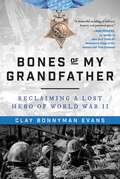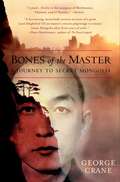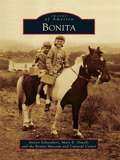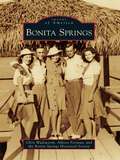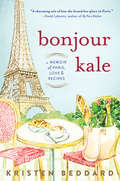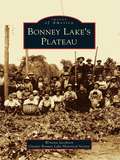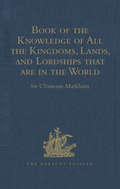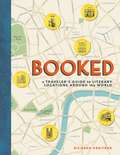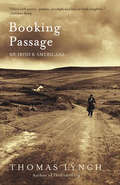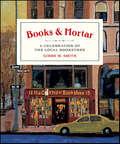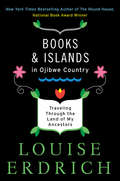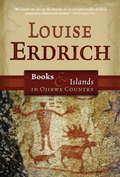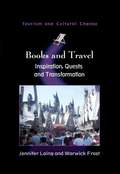- Table View
- List View
Bon Appetit!: Travels with knife,fork & corkscrew through France
by Peter MayleGastronomy is a wonderful starting point to study France and the French. As the retired schoolmaster from Provence says 'The religion of France is food. And wine, of course.' And they put their money where their mouth is, spending a greater proportion of their income on food and drink than any other nation in the world. Literally hundreds of gastronomic fairs and festivals take place throughout the year all over France - a frog fair, an hommage to the sausage, to the turnip, to the quiche and the noble Camembert. What kind of person is a snail-fancier? Is there a brotherhood of sausage connoisseurs? How can you devote an entire weekend to the French fry? Peter Mayle finds out and brings hilariously and affectionately to life the people who can get passionate about a frog's leg or a well-turned omelette. Over ten years ago he transformed our feelings about Provence, now he captures the irresistible essence of France herself - and her food.
Bon Courage: A French Renovation in Rural Limousin
by Richard WilesA rundown, rat-infested barn might not be many people’s vision of a dream home. But for Richard and Al, the cavernous building in a hamlet in the Limousin region of France is perfect. This hilarious and heartwarming tale of a new life in France resounds to the Gallic refrain, ‘Bon courage!’
Bon Courage: A French Renovation in Rural Limousin
by Richard WilesA rundown, rat-infested barn might not be many people’s vision of a dream home. But for Richard and Al, the cavernous building in a hamlet in the Limousin region of France is perfect. This hilarious and heartwarming tale of a new life in France resounds to the Gallic refrain, ‘Bon courage!’
Bon Courage: Rediscovering The Art Of Living (in The Heart Of France)
by Ken McAdamsOne year and one arduous home-renovation into their marriage, Ken and Bing head to the French countryside to celebrate their long-delayed honeymoon, swearing they're getting out of the home-fixing business for good. When they fall in love with the village of La Montagne Noire, they find themselves buying a fixer-upper and starting all over again-but this time, in French! McAdams recounts their mishaps and misadventures with humor, capturing the essence of French village life, the awkwardness of being foreigners in a close-knit town, the couple's hilarious linguistic pratfalls, and how the mammoth undertaking that threatens to tear their new marriage apart ultimately brings them closer together and helps them find a place in the community they have grown to love.
Bone Talk
by Candy Gourlay"A powerful, complex, and fascinating coming-of-age novel." -- Costa Book Award PanelA boy and a girl in the Philippine jungle must confront what coming of age will mean to their friendship made even more complicated when Americans invade their country.Samkad lives deep in the Philippine jungle, and has never encountered anyone from outside his own tribe before. He's about to become a man, and while he's desperate to grow up, he's worried that this will take him away from his best friend, Little Luki, who isn't ready for the traditions and ceremonies of being a girl in her tribe.But when a bad omen sends Samkad's life in another direction, he discovers the brother he never knew he had. A brother who tells him of a people called "Americans." A people who are bringing war and destruction right to their home...A coming-of-age story set at the end of the 19th century in a remote village in the Philippines, this is a story about growing up, discovering yourself, and the impact of colonialism on native peoples and their lives.
Bone by Bone: a gripping who-dunnit with a twist you don't see coming
by Carol O'Connell'Full of twists and turns and it will keep you guessing all the way through to the end!' 5* review'Kept me guessing till the very end. . . struggled to put it down!' 5* review'Carol O'Connell is a one of my favourite writers' 5* reviewTwenty years after the disappearance of his brother, ex-Army Criminal Investigator Oren returns to his family home to discover that human bones have been left on the doorstep. Oren's ageing father believes them to be the bones of Oren's lost brother, Josh, but Oren quickly discovers that the bones are not just his brother's. There is at least one more body.Faced with the horror of multiple victims, Oren is determined to find his brother's killer. But at what cost? In a town full of long-buried secrets, Josh's secret may be the most shocking of all . . .A uniquely gripping thriller, perfect for fans of Susie Steiner and Michael Connelly.'A tightly wrapped, expert combination of suspense, mystery and show-stopping character' New York Times'A fascinating cast of eccentrics, each character beautifully drawn, all of whom have something to hide' Guardian'Carol O'Connell is the most seductively devious writer... BONE BY BONE should make her a star' Daily Telegraph
Bones of My Grandfather: Reclaiming a Lost Hero of World War II
by Clay Bonnyman Evans“War, reclamation, and what Tim O'Brien called "the Lives of the Dead" are eternal literary themes for men. Clay Bonnyman Evans has honored that lineage with this masterful melding of military history and personal quest.”—Ron Powers, co-author of New York Times #1 bestsellers Flags of Our Fathers and True Compass, along with No One Cares About Crazy People and othersIn November 1943, Marine 1st Lt. Alexander Bonnyman, Jr. was mortally wounded while leading a successful assault on a critical Japanese fortification on the Pacific atoll of Tarawa, and posthumously awarded the Medal of Honor, the nation's highest military honor. The brutal, bloody 76-hour battle would ultimately claim the lives of more than 1,100 Marines and 5,000 Japanese forces. But Bonnyman's remains, along with those of hundreds of other Marines, were hastily buried and lost to history following the battle, and it would take an extraordinary effort by a determined group of dedicated civilians to find him. In 2010, having become disillusioned with the U.S. government's half-hearted efforts to recover the "lost Marines of Tarawa," Bonnyman's grandson, Clay Bonnyman Evans, was privileged to join the efforts of History Flight, Inc., a non-governmental organization dedicated to finding and repatriating the remains of lost U.S. service personnel. In Bones of My Grandfather, Evans tells the remarkable story of History Flight's mission to recover hundreds of Marines long lost to history in the sands of Tarawa. Even as the organization begins to unearth the physical past on a remote Pacific island, Evans begins his own quest to unearth the reclaim the true history of his grandfather, a charismatic, complicated hero whose life had been whitewashed, sanitized and diminished over the decades. On May 29, 2015, Evans knelt beside a History Flight archaeologist as she uncovered the long-lost, well-preserved remains of of his grandfather. And more than seventy years after giving his life for his country, a World War II hero finally came home.
Bones of the Master: A Journey to Secret Mongolia
by George CraneIn 1959 a young monk named Tsung Tsai (Ancestor Wisdom) escapes the Red Army troops that destroy his monastery, and flees alone three thousand miles across a China swept by chaos and famine. Knowing his fellow monks are dead, himself starving and hunted, he is sustained by his mission: to carry on the teachings of his Buddhist meditation master, who was too old to leave with his disciple. Nearly forty years later Tsung Tsai -- now an old master himself -- persuades his American neighbor, maverick poet George Crane, to travel with him back to his birthplace at the edge of the Gobi Desert. They are unlikely companions. Crane seeks freedom, adventure, sensation. Tsung Tsai is determined to find his master's grave and plant the seeds of a spiritual renewal in China. As their search culminates in a torturous climb to a remote mountain cave, it becomes clear that this seemingly quixotic quest may cost both men's lives.
Bonita (Images of America)
by Bonita Museum and Cultural Center Mary E. Oswell Steven SchoenherrThe small rural community of Bonita is nestled in the fertile valley of the Sweetwater River. For over a century, families from nearby San Diego and Chula Vista have built secluded homes on large lots carved from the pioneer ranches that emerged in the 1870s on Rancho de la Nacion. Ulysses S. Grant Jr. and the Marstons and Allens built homes designed by architects such as Irving Gill and William S. Hebbard. They relished the rural equestrian lifestyle of their valley, and resisted the modernization that began after World War II with highways, shopping centers, and subdivisions.
Bonita Springs
by Allison Fortuna Chris Wadsworth Bonita Springs Historical SocietyThe pioneer history of Bonita Springs stretches back to the 1880s, when an Alabama cotton planter named B. B. Comer bought 6,000 acres of land along Surveyors Creek. He started a tropical fruit plantation, and his tiny village became known as Survey, in honor of the U.S. Army engineers who had first surveyed the region during the Seminole Wars decades before. When Florida started to boom in the early 20th century, investors bought up much of the land in the area. They quickly gave the community the more attractive moniker Bonita Springs and renamed the nearby creek the Imperial River. Beautiful beaches and world-class hunting and fishing soon turned Bonita Springs into a tourist mecca. Popular roadside attractions sprang up along the fast-growing Tamiami Trail, including the Everglades Wonder Gardens, the original Shell Factory, and the famous Naples-Fort Myers Greyhound Track.
Bonjour Kale
by Kristen BeddardA memoir of love, life, and recipes from the woman who brought kale to the City of Light The story of how one expat woman left her beloved behind when she moved to France-her beloved kale, that is. Unable to find le chou kale anywhere upon moving to the City of Light with her new husband, and despite not really speaking French, Kristen Beddard launched a crusade to single-handedly bring kale to the country of croissants and cheese. Infused with Kristen's recipes and some from French chefs, big and small (including Michelin star chef Alain Passard) Bonjour Kaleis a humorous, heartfelt memoir of how Kristen, kale, and France collide.
Bonne Chance!: Building a Life in Rural France
by Richard WilesDeep in the Limousin countryside, Richard Wiles bought his dream home. But he didn’t anticipate renovating the dilapidated farmhouse during the insect plagues of summer and the harsh blizzards of winter. Told with humour and optimism, this is a unique tale of overcoming the formidable challenges of building a home, and a life, in France.
Bonne Chance!: Building a Life in Rural France
by Richard WilesDeep in the Limousin countryside, Richard Wiles bought his dream home. But he didn’t anticipate renovating the dilapidated farmhouse during the insect plagues of summer and the harsh blizzards of winter. Told with humour and optimism, this is a unique tale of overcoming the formidable challenges of building a home, and a life, in France.
Bonnes Vacances: A Crazy Family Adventure in the French Territories
by Rosie MillardRosie Millard’s tour of the French Overseas Departments and Territories (the ‘Dom-Toms’) with her husband and four young children took her family across five continents. Candid, humorous and slightly mad, this memoir offers insights, amusement and hope for anyone who has ever travelled en famille.
Bonney Lake's Plateau
by Greater Bonney Lake Historical Society Winona JacobsenThe story of Bonney Lake and the plateau is not about towns and their storefronts, but of the enduring people who settled there before and after Washington achieved statehood. In spite of their brief presence, Michael Connell and Reuben Finnell are names credited for many of the area's key landmarks. In 1864, pioneer William B. Kelley arrived at the plateau. His public service as a territorial legislator and county auditor made him one of the most respected individuals of eastern Pierce County. Other pioneers, such as the Moriarty and Vandermark families, engaged in logging and farming on the plateau, which continued to be considered a wilderness. Oscar "Doc" Bowen, one of the settlers who arrived from the 1930s dustbowl, had a spiritual impact when he called for construction of the area's first church. Less than two decades later, Kenneth Simmons saw potential for further growth and pressed to incorporate the plateau's west end--forming the town of Bonney Lake.
Book Lust to Go: Recommended Reading for Travelers, Vagabonds, and Dreamers
by Nancy PearlAdventure is just a book away as best-selling author Nancy Pearl returns with recommended reading for more than 120 destinations around the globe. Book Lust To Go connects the best fiction and nonfiction to particular destinations, whether your bags are packed or your armchair is calling. With stops from Texas to Timbuktu, Nancy Pearl's reading recommendations will send you on your way.
Book Towns: Forty-Five Paradises of the Printed Word
by Alex JohnsonThis ultimate travel guide for bibliophiles explores the most literary towns across the globe—full of charming bookshops, fairs, festivals, and more.The so-called “Book Towns” of the world are dedicated havens of literature, and the ultimate dream of book lovers everywhere. Book Towns takes readers on a richly illustrated tour of the forty semi-officially recognized literary towns around the world and outlines the history and development of each community, and offers practical travel advice.Many Book Towns have emerged in areas of marked attraction, such as Ureña in Spain or Fjaerland in Norway, where bookshops have been set up in buildings including former ferry waiting rooms and banks. While the UK has the best-known examples at Hay, Wigtown and Sedbergh, author and dedicated book collected Alex Johnson visits such far-flung locations as Jimbochu in Japan, College Street in Calcutta, and major unofficial “book cities” such as Buenos Aires.
Book of the Eskimos
by Dagmar FreuchenPeter Freuchen was a Danish explorer who had spent many years among the Eskimo people. This book is crammed full of information on the history, life-styles, and rapid changes in this civilization's lives.
Book of the Knowledge of All the Kingdoms, Lands, and Lordships that are in the World: And the Arms and Devices of each Land and Lordship, or of the Kings and Lords who possess them. Written by a Spanish Franciscan in the Middle of the XIV Century. Published for the First Time with Notes by Marcos Jiménez de la Espada, in 1877 (Hakluyt Society, Second Series #Vol. 29)
by Clements MarkhamTranslation of the Libro del Conoscimiento de todos los reynos. This is a new print-on-demand hardback edition of the volume first published in 1912.
Booked: A Traveler's Guide to Literary Locations Around the World
by Richard KreitnerA practical, armchair travel guide that explores eighty of the most iconic literary locations from all over the globe that you can actually visit. A must-have for every fan of literature, Booked inspires readers to follow in their favorite characters footsteps by visiting the real-life locations portrayed in beloved novels including the Monroeville, Alabama courthouse in To Kill a Mockingbird, Chatsworth House, the inspiration for Pemberley in Pride and Prejudice, and the Kyoto Bridge from Memoirs of a Geisha. The full-color photographs throughout reveal the settings readers have imagined again and again in their favorite books. Organized by regions all around the world, author Richard Kreitner explains the importance of each literary landmark including the connection to the author and novel, cultural significance, historical information, and little-known facts about the location. He also includes travel advice like addresses and must-see spots. Booked features special sections on cities that inspired countless literary works like a round of locations in Brooklyn from Betty Smith's iconic A Tree Grows in Brooklyn to Jonathan Lethem's Motherless Brooklyn and a look at the New Orleans of Tennessee Williams and Anne Rice. Locations include: Central Park, NYC (The Catcher in the Rye, JD Salinger) Forks, Washington (Twilight, Stephanie Meyer) Prince Edward Island, Canada (Anne of Green Gables, Lucy Maud Montgomery) Kingston Penitentiary, Ontario (Alias Grace, Margaret Atwood) Holcomb, Kansas (In Cold Blood, Truman Capote) London, England (White Teeth, Zadie Smith) Paris, France (Hunchback of Notre Dame, Victor Hugo) Segovia, Spain, (For Whom the Bell Tolls, Ernest Hemingway) Kyoto, Japan (Memoirs of a Geisha, Arthur Golden)
Booking Passage: We Irish and Americans
by Thomas LynchIn thirty-five years and dozens of return trips to Ireland, Thomas Lynch has found a template for the larger world inside the small one, the planet in the local parish. Part memoir, part cultural study, Booking Passage is a brilliant, often comedic guidebook for those "fellow travelers, fellow pilgrims" making their way through the complexities of their own lives and times.
Books & Mortar: A Celebration of the Local Bookstore
by Gibbs M. SmithThe local bookstore, a place of wonder, refuge, and rejuvenation for book lovers the world over. Books & Mortar is a celebration of these literary strongholds. Sixty-eight oil paintings capture these storefronts at a moment in time, and pair the artwork with anecdotes about the shops and reflections on bookselling by many of the owners themselves. A delightful gift for an avid reader, an inspiration for any bookstore owner, Books & Mortar is the perfect keepsake for anyone’s personal library.
Books and Islands in Ojibwe Country
by Louise ErdrichFor more than three decades, Louise Erdrich has enthralled readers with dazzling novels that paint an evocative portrait of Native American life. <P><P>In Books and Islands in Ojibwe Country, Erdrich takes us on an illuminating tour through the terrain her ancestors have inhabited for centuries: the lakes and islands of southern Ontario. Summoning to life the Ojibwe's sacred spirits and songs, their language and sorrows, she considers the many ways in which her tribe--whose name derives from the word ozhibii'ige, "to write"--have influenced her. Her journey links ancient stone paintings with a magical island where a bookish recluse built an extraordinary library, and she reveals how both have transformed her. A blend of history, mythology, and memoir, Books and Islands in Ojibwe Country is an enchanting meditation on modern life, natural splendor, and the ancient spirituality and creativity of Erdrich's native homeland--a long, elemental tradition of storytelling that is in her blood.
Books and Islands in Ojibwe Country: Traveling Through the Land of My Ancestors
by Louise ErdrichFor more than twenty years Louise Erdrich has dazzled readers with the intricately wrought, deeply poetic novels which have won her a place among today's finest writers. Her nonfiction is equally eloquent, and this lovely memoir offers a vivid glimpse of the landscape, the people, and the long tradition of storytelling that give her work its magical, elemental force. <P><P> In a small boat like those her Native American ancestors have used for countless generations, she travels to Ojibwe home ground, the islands of Lake of the Woods in southern Ontario. Her only companions are her new baby and the baby's father, an Ojibwe spiritual leader, on a pilgrimage to the sacred rock paintings their people have venerated for centuries as mystical "teaching and dream guides," and where even today Ojibwe leave offerings of tobacco in token of their power. With these paintings as backdrop, Erdrich summons to life the Ojibwe's spirits and songs, their language and sorrows, and the tales that are in their blood, echoing through her own family's very contemporary American lives and shaping her vision of the wider world. <P><P>Thoughtful, moving, and wonderfully well observed, her meditation evokes ancient wisdom, modern ways, and the universal human concerns we all share. "This book is a treasure and a delight. "-Minneapolis Star Tribune
Books and Travel
by Warwick Frost Jennifer LaingThe books that we read, whether travel-focused or not, may influence the way in which we understand the process or experience of travel. This multidisciplinary work provides a critical analysis of the inspirational and transformational role that books play in travel imaginings. Does reading a book encourage us to think of travel as exotic, adventurous, transformative, dangerous or educative? Do different genres of books influence a reader's view of travel in multifarious ways? These questions are explored through a literary analysis of an eclectic selection of books spanning the period from the eighteenth century to the present day. Genres covered include historical fiction, children's books, westerns, science-fiction and crime fiction.


